snowberry
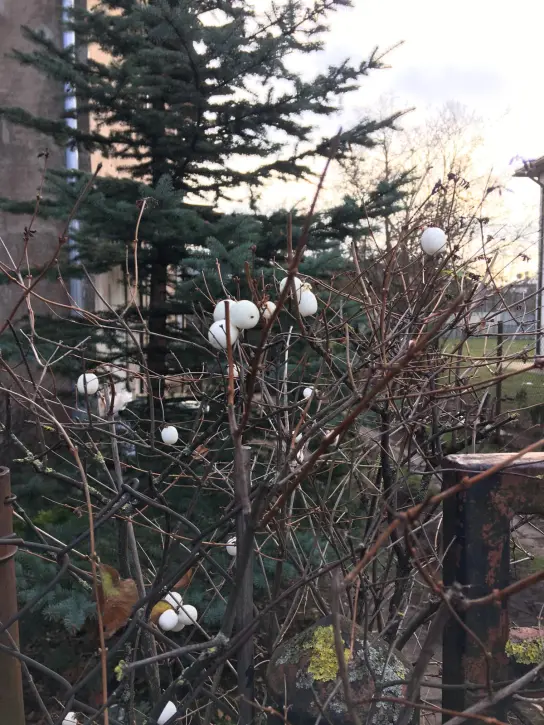
Snowberries may be harmless
What are snowberries?
Quite popular ornamental deciduous shrubs. Although they’re native to America, they’ve made their way into Europe and are a common sight in the wild. I’m going to be talking mainly about the common snowberry, Symphoricarpos albus.
Image: Symphoricarpus albus var. laevigatus (Fernald) S. F. Blake in late december
The problem
I wanted to taste them and decided to check how good of an idea that is. Unfortunately, many sources claim they’re poisonous, and there are several reports of poisoning. However, are they really? Why? What is the harmful agent? What are the negative effects? How potent are they? The internet is littered with inconsistencies on all of these topics to the point that I find it doubtful that they are poisonous at all. I can’t even find a reported death ascribed to this beautiful berry. Opinion
I believe the berry is not very harmful at all, and I will support my opinion by looking at its chemical constituents, interaction with the surrounding fauna, reports of poisonings and the relation between the chemical constituents and supposed toxic effects. Finally, I’ll present some preliminary original research on their toxicity. Chemical composition of the berry
[ТД Гусарова (2010), Фармакогностичне вивчення плодів Simphoricarpos albus та розробка на їх основі лікарського засобу. (Pharmacognostic study of fruits of Simphoricarpos albus and development of medicines based on them) Found in http://dspace.nuph.edu.ua/bitstream/123456789/272/1/gusarova_10.pdf . Accessed 2019-12 < notable, since the site seems to be down most of the time.]
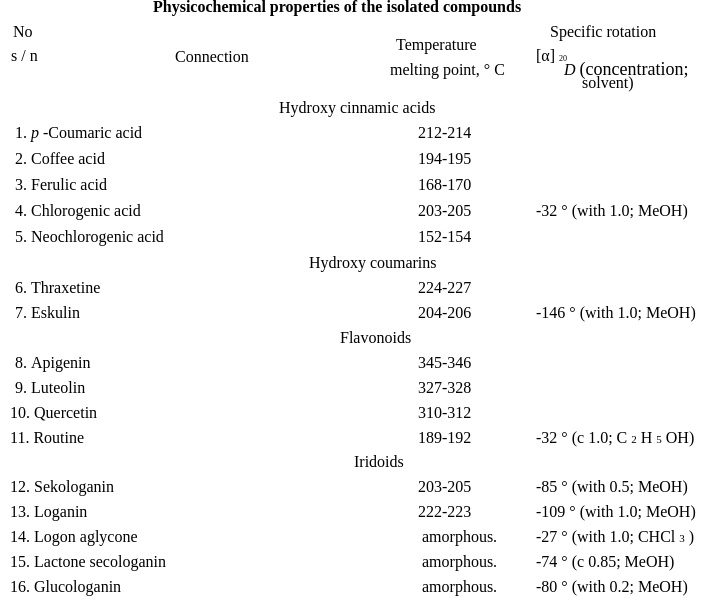
As with most information regarding this berry, inconsistencies can be found. Cited above is the most throughout description of its chemical makeup I could find, all in Ukrainian. I used google translate to skim it. You should see an image of a Google-translated table of what Gusarova managed to extract from the plant, apart from obvious and irrelevant things like amino acids.
Let’s go through them and think of what negative effects they could have on a person. First off, the hydroxycinnamic acids and the flavanoids are all boring and found in other foods, definitely not harmful. This is common knowledge in the field.
Iridoids
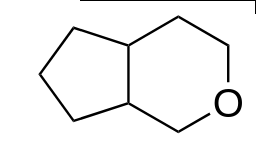
[Yoshihiro HARIGAYA et al. (2007) Naturally Occurring Secoiridoids and Bioactivity of Naturally Occurring Iridoids and Secoiridoids. A Review, Part 2. https://doi.org/10.1248/cpb.55.689 . Get ready to scroll copious amounts.]
[B. C. Mohanta et al. (2007) Naturally Occurring Iridoids, Secoiridoids and Their Bioactivity. An Updated Review, Part 3 https://doi.org/10.1248/cpb.57.765 . Get ready to scroll copious amounts.]
Iridoids are named based on their chemical structure, containing a bicyclic ring system. Many iridoids are biologically active, however, it’s difficult to find reports of harmful ones – almost all reports show beneficial effects
A Google Scholar query “harmful iridoids” seemingly yields no relevant output. Regardless, it’s best to overview the ones found by Gusarova
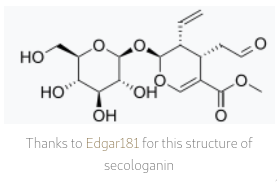
Secologanin (‘sekologanin’) is boring. A quick search returns no bioactivity studies, but it’s found in a plethora of bioactive plants as an intermediate in the biosynthesis of other chemicals, such as other secoiridoids. It’s very well known, and therefore, if it had any significant biological activity, I find it likely it would have already been discovered.
Lactone secologanin is an interesting designation. I can’t find it on the internet, and the dissertation doesn’t have a structure for it. The only possible way for it to be a lactone without losing any carbon atoms is for the right side ring (pic right) to have a carbonyl stiched up at the double bond. I can’t find that structure using Reaxys. If it can lose carbon atoms, then it could be the left ring, or a cyclization on the right side (pic right). I’m going to have to ignore it for now.
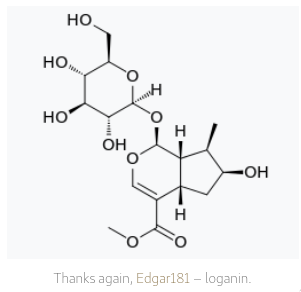
Loganin has a variety of biological activities attributed to it, such as neuroprotection
[log1]
, nootropic effects [log2]
, reduction of hyperglycemia and dyslipidemia [log3]
and other nice things. Basically, great stuff. It’s an acetylcholinesterase inhibitor (AChEi) [log2]
, which will be important later. High AChEi levels can be toxic.[ghisalberti1998.pdf]
Loganin aglycone is, unsurprisingly, the loganin structure with the sugary part cleaved off. There is a good amount of evidence that iridoids act as pro-drugs for iridoid aglycones in vivo, and so there’s not much precedent for looking at this in more detail.
[makarevich2009%20(1).pdf]
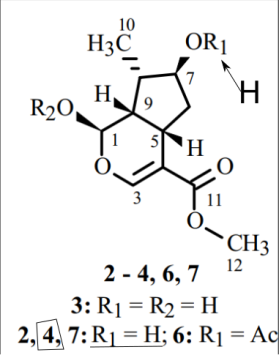
Glucologanin is unique. It has only ever been isolated from the snowberry, and so it’s unsuprising that there’s no research on it. Unfortunately, its structure is described in cryptic terms in the few papers where it can be found: “Enzymatic hydrolysis of (glucologanin)4 was carried out in order to establish its
structure. This formed loganigenin (3) and D-glucose. These same products were obtained by hydrolysis of loganin monoglycoside (2). Therefore, it was assumed that ths (sic) compound was a diglycoside, glucologanin.” Their attached structure is also shitty, not defining ‘R2’ (pic right)
[glucologanin]
. Of course, it has a sugar attachment, but ‘diglycoside’ does not fit as a name for it if it has a single glycoside attachment. Either way, further reading shows the authors probably mean a single molecule of the disaccharide gentiobiose attached where ‘R2’ is located. This means that glucologanin is likely to have effects similar to loganin after the glucose is cleaved off, acting as a pro-drug. Hydroxycoumarins
These could be interesting and relevant. For example, 4-hydroxycoumarins can be strong anticoagulants to the point of being dangerous. Gusarova's dissertation mentions that 6 is ‘Thraxetine’ and 7 is ‘Eskulin’, pic below. Neither are 4-hydroxy, so hopefully noone is going to bleed to death from snowberries.
Funnily enough, the structure of ‘eskulin’ corresponds to the structure of fraxetin, and the ‘thraxetine’ corresponds to aesculin. Wonder how the dissertation managed to get approved without anyone noticing. Regardless, fraxetin is safe – in fact it’s neuroprotective, an antioxidant, antihyperglycemic and I’m sure it does other great things, but I can’t find anyone claiming it’s harmful.
I find aesculin controversial. Many sources claim it’s toxic, but most lack references. The effects are supposedly severe gastroenteritis, lack of coordination, twiching, vomiting, diarrhoea, weakness, paralysis, unconsciousness. However, I can’t find anything regarding this on Google Scholar.
Aesculin is typically associated with the horse-chestnut, Aesculus hippocastanum, the seeds of which can supposedly be poisonous, causing the aforementioned effects.
I think this might be similar to the "association" of nicotine to lung cancer because smoking causes lung cancer.
At most, a line of citations can be followed as such:
Wikipedia claims toxicity, references
[1]
.[1]
only says that “Horse chestnut may have an additive anticoagulant effect due to aesculin, a hydroxycoumarin”, giving a reference [2]
.[2]
is called “Escin improves sperm quality in male patients with varicocele-associated infertility.”Not only does the title give away the fact that the article is unlikely to contain proof, but also “aesculin” and “esculin” do not appear anywhere in the article. Overall, the purported toxicity of aesculin can’t be trusted, but the supposed effects should be noted for later.
Other potential toxic contenders
Some places, like the Wiki article, claim the snowberry contains the AChEi chelidonine, which is also a nonspecific cholinesterase inhibitor. There is only one result of this in the scientific literature I can find, a citation on Google Scholar – Szaufer M, Kowalewski Z: Chelidonine from Symphoricarpos albus. I can’t read the article, it seems unlikely others would not detect it and even if so, another AChEi alongside loganin is not that interesting.Other sites claim there are toxic saponins in the snowberry. This may be true, but there are saponins in many edible items like beans. Typically, they are present in insufficient quantities to cause harm, or are harmless. Furthermore, the conception that saponins tend to be toxic at all may be fallacious. Lastly: “The analysis of saponins is complex (..) many early reports of the saponin content of food plants and processed food should be treated with caution”
[saponins]
.It’s possible to find claims of isoquinoline alkaloids in snowberries, but they’re referenced poorly. I can’t find anything on google scholar regarding this. Maybe they refer to chelidonine, as that can be viewed as an isoquinoline derivative.
It’s important to note that it’s possible to find reports of some other chemicals in the snowberry, but they’re all boring metabolic products found in other foods insofar as I’ve seen.
Summary of potentially toxic substances in the snowberry
1. Loganin as an AChEi2. Chelidonine as an AChEi and plasma cholinesterase inhibitor
3. Aesculin with gastroenteritis, lack of coordination, twiching, vomiting, diarrhoea, weakness, paralysis, unconsciousness as possible effects
4. Saponins with unknown effects
5. Unknown isoquinolines or other compounds
Of which 2., 4. and 5. seem like they could be absent, 3. and 4. are likely harmless and 1. could also be harmless depending on concentration.
Snowberry interaction with the surrounding fauna
Birds
[Food habits of some winter bird visitants Ira Noel Gabrielson, Pine Grossbeak (pinicola enucleator):]
Birds are well known to eat the berries with no ill effects.
It’s easy to argue that birds are too different from people, especially considering their digestive systems. However, searching for 5 minutes I failed to find berries that birds eat that are harmless to them yet toxic to people. There are some reports of birds eating Datura seeds, but none show good references.
[LOST REFERENCE, TO FIND DATURABIRDS2]
Similarly, there are reports to the contrary, claiming birds avoid eating datura seeds.
This ‘publication’ is 12 very short lines long and costs 9 dollars to read, quite remarkable. Regardless, this is just one animal that eats them with no ill effects.
Livestock, other animals
[Four species of range plants not poisonous to livestock. https://naldc.nal.usda.gov/download/CAT86200088/PDF ]
There have been many unclear reports of poisoned livestock regarding differing Symphoricarpos species. Again, periodically someone will publish that a particular species is either toxic or not toxic. It’s quite certain that Symphoricarpos vaccinioides is not toxic to livestock at all, as there is an actual write-up that mentions testing it; the write-up also contains descriptions of some of the existing contradictions in literature. Although S. vaccinioides is a different species, this along with the fact that the toxicity of other species is dubious should shed extra doubt on the toxicity of S. Albus.
The median lethal dose for snowberries has been evaluated in mice. Supposedly, it’s 435g/kg in mice
[poisonings]
. I suggest you look at that number very carefully. I can’t access the original citation (Chavant et al.), but I’m not surprised that a 1kg animal, when stuffed with 0.44kg of any material, will die. Try to eat half your bodyweight in anything and survive. People
It’s hard to find definitive repots of people being poisoned. There are reports that are too old to be trusted, like a 19th century report describing “vomiting, purging and delirium, followed by a semi-comatose state” in 4 poisoned children. One is alleged to have ‘narrowly escaped death’, but what does narrowly escaping death even mean? Especially in the 19th century, when medicine was so advanced women were considered to be smaller men with inverted dicks and excessive male copulation caused debility.Other, possibly relevant reports claim children in Poland have been poisoned in ‘recent years’, but the reference they give is ‘Chelidonine from S. Albus’, which seems unlikely to be the primary source for something like this, and can’t be read, as mentioned in the chemistry section. From 1975 through 1976, 8 cases were supposedly reported in the US, of which only one was magically symptomatic. So why were they even reported? How is it poisoning if there are no symptoms? Lastly, the reference given for this is ‘oral communication’, you can’t make this shit up!
Another report: 2 year old child eats the fruit, 2h later fruit is found in his vomit. No other symptoms. Many problems with this: Who was there to observe the child eat the fruit and not stop it? This had to be done, otherwise noone could give the 2h estimate. Also, the child must have really avoided chewing for it to be identifiable after 2h in the child’s digestive juices. And 2 year old children are small – could he really swallow the berry whole without choking? It would sure as hell be hard for me to swallow it whole. Lastly, this statement has no reference given.
https://www.em-consulte.com/en/article/1229936
This report describes the poisoning of a 4 year old girl. There is a picture of an excerpt, available publically on the site, on the right.

She was at her grandparent’s house in the morning. The grandparents had an entire stash of drugs lying around. The child says she had eaten “some white candies”.
Let’s talk about some things 4 year old kids say, in my experience:
1) Random shit
2) Random shit that does not make sense
3) Some coherent sentences
I’m confident I don’t have to mention what 4 year old, hallucinating kids may say. It’s also useful to consider words that 4 year old kids always know, and can differentiate, in my experience:
1) Berries
2) Candy
The article mentions the child later identified the snowberry as the ‘white candies’ she had eaten, yet I have a distant, 4 year old relative that will always answer ‘yes’ when asked a binary question, regardless of what the question contents are. Let me therefore give you a possible scenario:
Doctors: Did you eat this? *show picture*
Child: Yes.
Let me give you another possiblity, considering how doctors tend to speak:
Doctors: This is what you ate, isn’t it? This is what you ate, right? That’s it!
Child: Uhh…
Doctors: I FUCKING KNEW IT.
In short, I think it ate the grandfather’s stash. The article says no drugs were missing from their stock, but I’ve never seen anyone pay close attention to their pill counts, let alone old, atherosclerotic geezers that may be physically incapable of doing so.
I may seem like an asshole since I assume the doctors could not properly interrogate a child. However, let’s look at the symptoms described:
“The child had moderate sinusal
[sic]
bradycardia around 60/mn[sic]
”“EEG revealed diffuse moderate slowing of brain activity
[..]
EEG control 7 days later revealed the same alterations” Well call me crazy, but I think the child may just be slow, that’s not much of a symptom.Mental symptoms – “drowsiness”, “altered vigilance”, “hallucinations”, “confusion”.
The Glasgow coma scale readings are basically normal for a child that age.
Now the article mentions that the plant contains chelidonine, an AChEi, yet they call these symptoms an anticholinergic toxidrome. This judgement is also inconsistent with bradycardia. In fact, anticholinergic poisoning is only consistent with the mental state change, which could have been caused by anything. Therefore, the doctors are idiots and I’m warranted in assuming they can’t interrogate a child. This discussion of symptoms leads nicely to a further comparison between them and the substances found in snowberries:
Effects vs substances
The effects reported in most places are vomiting and altered mental state (hallucinations, comatose state). The comatose state and vomiting could be explained by aesculin if it really is harmful. The hallucinations could not be explained by anything that I could find. If bradycardia is considered as an effect, AChEi poisoning could cause it.Overall, the chemical composition does not seem that intimidating to me, and the poisoning reports I find seem very untrustworthy. I’d expect there to be a lot more children getting poisoned by them if they really are harmful, as I’m sure they appeal to many.
Let’s test the berries!
Original research
All of the following reports are in relation to the titular S. albus:1) A 22 year old caucasian CYP2D6 deficient male chewed up a berry and spit it out, bearing no observable effects. A month later, he ate one full berry, again with no observable effects, except perhaps a loose stool the next day.
2) Next year, same 23 year old male ate 1 berry; a week later, 2; so on until 4. No ill effects were observed, but the berries leave an aftertaste that’s not very nice so he quit experimenting.
3) A 27 year old caucasian male ate 1 berry. No effects were observed.
Further research was discontinued because they just don’t taste good enough.
Conclusion
Contrary to the prevailing belief, snowberries are either not poisonous, or are only mildly poisonous. If you eat them and die, it's not my fault.